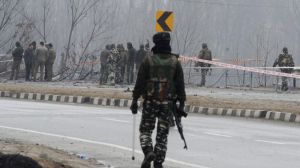A warlord who eats humans to fabulous creatures: The many tales from the Himalayas
Himalayan rocks have many stories to tell — from the mangled contours formed out of tectonic pressure to fossilised ammonites that died out with the dinosaurs.
 Standing tall: Nanga Parbat reflected in a pond at Fairy Meadows. (Photo: Getty Images/Thinkstock)
Standing tall: Nanga Parbat reflected in a pond at Fairy Meadows. (Photo: Getty Images/Thinkstock)
Ascending into the upper reaches of the Raikot Valley, first by Jeep, and, then, on foot, I can recall numerous accounts of alpine adventure from this remote and rugged region below Nanga Parbat. Often called the “killer mountain”, Nanga Parbat has a treacherous history, having claimed the lives of 31 mountaineers before it was finally summitted by Hermann Buhl in 1953. While this 8,126 m peak has been demonised by various authors, it also evokes bucolic charms. German expeditions in the 1930s dubbed the high grasslands at the base of Nanga Parbat the “Marchenwiese” or “Fairy Meadows” for they present an idyllic contrast to the forbidding countenance of the naked mountain that rises overhead.
Nanga Parbat lies in disputed territory, at the edge of Kashmir and across the Line of Control that separates Indian and Pakistani troops. It isn’t an easy place to visit, though I am finally able to travel there during a brief lull in hostilities. Accompanying me is Didar Ali, who comes from Hunza and is an entertaining raconteur. As we trek through a forest of pines, junipers and birches, he tells me folk tales about a fearsome warlord named Sri Badat who dined on human flesh, as well as swarms of fairies that guard a magical tree, laden with pearls, that grows on the summit of Nanga Parbat. Didar also explains how shepherds wrap butter in birch bark and bury it in the ground to make a strong but flavourful cheese. Along our route, he gathers lichens growing on dead conifers, with which he brews a refreshing, rust-coloured tea that Didar calls “juniper blood”.
For the past three years, I’ve been researching the natural history of the Himalayas, which has given me an opportunity to visit many areas that I hadn’t explored before. Though I have gazed upon some of the highest peaks in the world and peered down into the deepest gorges, what fascinates me more than anything are the stories I have gathered, including scientific narratives, archaic legends, sacred scriptures and jungle lores. The Himalayas are a voluminous archive, like a giant bookcase stretching 2,500 km from Nanga Parbat to Namche Barwa, documenting every subject from hydrology to botany to even philosophy.
 The Takin in Bhutan. (Photo: Stephen Alter)
The Takin in Bhutan. (Photo: Stephen Alter)
The origins of this many-storied range are chronicled in a multi-layered creation myth told by a chorus of different voices. On one level, it is a tale of plate tectonics, in which the fragments of primordial continents drifted together, pushing up a corrugated arc of ridgelines. Over millions of years, what was once the floor of the Tethys Sea has risen more than 8 km into the sky. Near Nanga Parbat lies the confluence of the Gilgit and Indus rivers, known as “the fulcrum of Asia,” where the Western Himalayas collide with the Hindu Kush and Karakoram. During the early part of the 20th century, geologists like DN Wadia excavated mysteries embedded in stone, revealing the stratified legacy of Himalayan orogeny. Wadia’s writings are as literary as they are scientific, particularly when he explains how the Pir Panjal range in Kashmir has a “writing desk” shape, after which he goes on to muse: “A sand grain or a pebble of the rocks is not a mere particle of inanimate matter, but is a word or phrase in the history of the earth, and has much to tell of a long chain of natural operations which were concerned in its formation.”
Himalayan rocks have many stories to tell — from the mangled contours formed out of tectonic pressure to fossilised ammonites that died out with the dinosaurs. In Ladakh, Tzewang Rigzen and I tracked down Stone Age petroglyphs etched on boulders by nomadic hunters who wandered through these highlands more than 7,000 years ago, when the last ice age ended and glaciers began to retreat. These remarkable images of ibex, blue sheep, urial, yaks and snow leopards are the first field guides to Himalayan wildlife and recall desperate struggles for survival.
At the other end of the spectrum, in the Eastern Himalayas, the Bugun people of Arunachal Pradesh recount a folktale, collected by Verrier Elwin. In this story, which explains the origin of mountains, there are two brothers, Nipu and Nili, one of whom created the earth, and, the other, the sky. When Nipu tried to place the sky as a lid over the earth, it was too small, so Nili squeezed the land together to make it fit and the Himalayas were formed where the earth wrinkled up into ridges.
While visiting Eagle Nest Wildlife Sanctuary in Arunachal Pradesh, I happen to meet a Sherdukpen storyteller, Dorjee Khandu, who regales us with tribal lore as we sit around a smoky campfire. He explains how his people are the descendants of a noble hunter, Asu Gyaptong, who shot an arrow at a wild boar and followed the wounded animal down from the mountains into the plains. There, he finally killed and butchered the boar, then cooked it with salt from Tibet and wild herbs gathered in the forest. As Khandu recounts: “When Asu Gyaptong shared this feast with the Bodo people, who live at the foot of the mountains, they found it delicious and invited him to come back every year, which is how the Sherdukpen began trading between Tibet and Assam.”
 A blood pheasant on the lower slopes of the Kanchenjunga. (Photo: Stephen Alter)
A blood pheasant on the lower slopes of the Kanchenjunga. (Photo: Stephen Alter)
In Bhutan, there are many myths of fabulous creatures such as the flying tigress who carried Guru Padmasambhava on her back and made her home at Taktsang, the “Tiger’s Nest”. We also hear parables of the “divine madman”, Drukpa Kunley, who created the Takin, Bhutan’s national animal. After eating a huge meal of beef and mutton, he gathered up the bones and brought the two animals back to life again as a single creature, which is why the Takin looks like a cross between a cow and a goat. My guide, Tandin Gyeltshen, also relates an amusing fable about the yak and the buffalo, who went into business together. The yak borrowed the buffalo’s coat so that he could travel to Tibet for trade but he never returned, which is why the buffalo has no hair and keeps glancing over his shoulder with a resentful, cheated expression.
Most of my research was conducted on foot, trekking to the base of Himalayan giants like Dhaulagiri, Annapurna and Chomolungma, better known as Everest. On the lower slopes of the Kanchenjunga, where cloud forests are abloom with dozens of species of rhododendron, we come upon a covey of blood pheasant, the sacred Sumong pho of Lepcha mythology. These spectacular birds are said to live in a secret paradise, from which they emerged years ago to rescue the ancestral inhabitants of Sikkim, after a great flood rose up, inundating the valleys and mountains. Stories like this illuminate the vertiginous terrain and the many species it contains, each tale an episode in the eternal epic of the Himalayan biography.
Stephen Alter is the author of 20 books of fiction and non-fiction. Wild Himalaya: A Natural History of the Greatest Mountain Range on Earth will be published by Aleph in August.
This article appeared in the print edition with the headline ‘Many-storied Mountains’
Photos





- 01
- 02
- 03
- 04
- 05


























